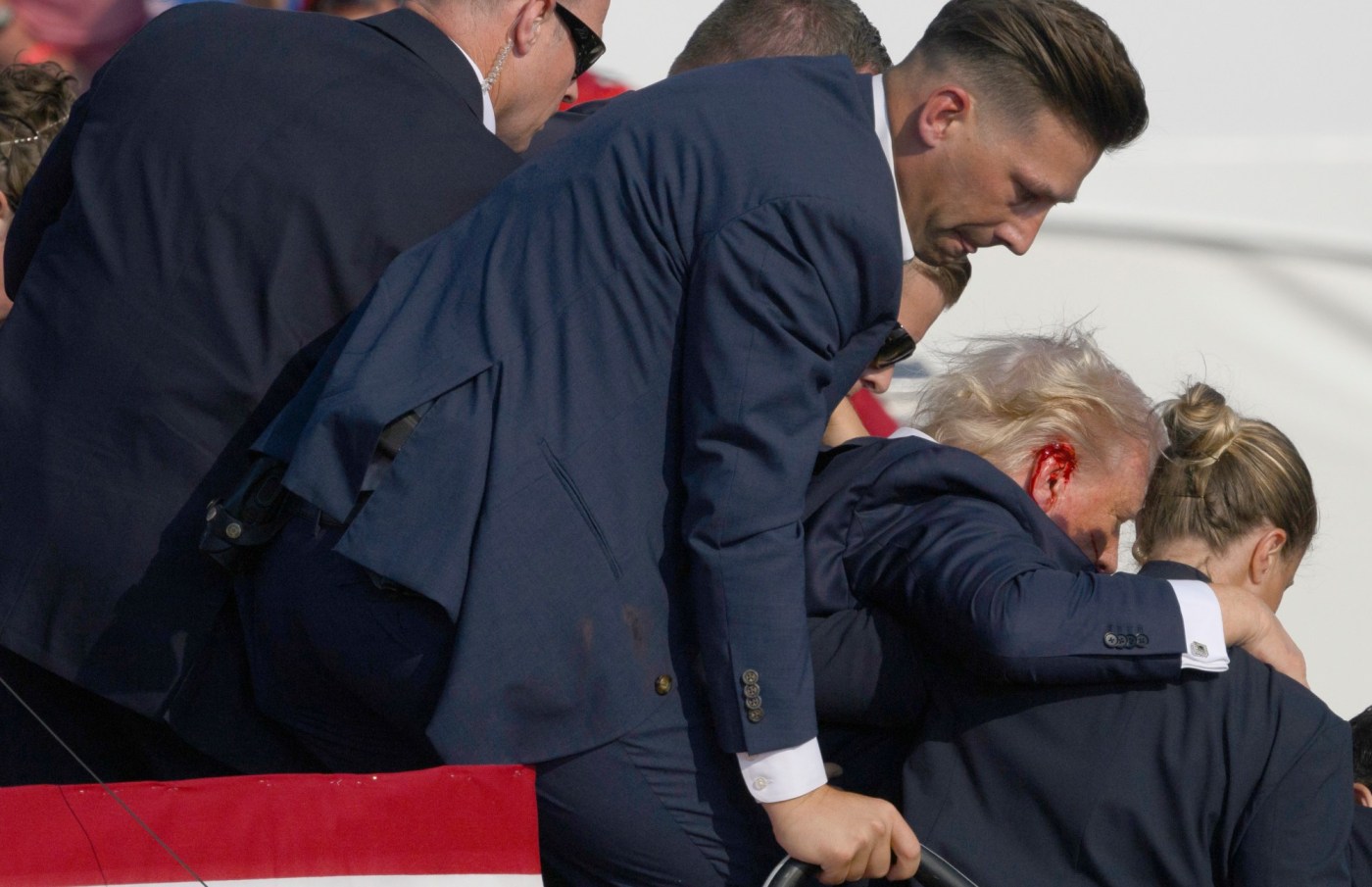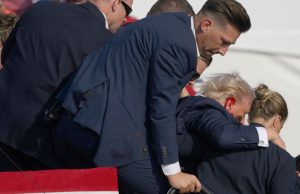
Senate probe finds Secret Service failures at Trump rally shooting
WASHINGTON — A bipartisan Senate committee report released Wednesday found numerous Secret Service failures related to the July 13 near assassination of former President Donald Trump and recommended ways to help prevent another incident.
The Senate Homeland Security and Governmental Affairs Committee, in its ongoing investigation into the shooting at a Pennsylvania rally, said the agency fell short in coordination with local law enforcement and drone operation that would have helped ensure the area was safe.
And the Secret Service failed to secure the rooftop from which the shooter fired at Trump and did not react to the suspicious person spotted at the rally, the report states.
“The Committee finds that USSS failures in planning, communications, security, and allocation of resources for the July 13, 2024 Butler rally were foreseeable, preventable, and directly related to the events resulting in the assassination attempt that day,” the report states.
Sen. Richard Blumenthal, D-Conn., told reporters the findings of the investigation determined “a perfect storm of stunning failure” was a result of accumulation of errors by the Secret Service on that day.
“In a sense, a lot of these individual failings, if corrected at the time, might have prevented this tragedy, and clearly it was a tragedy,” Blumenthal said. “A man died, a former president was almost killed, and it was completely preventable.”
The report calls on the Secret Service to designate a single individual to approve all plans for a protective event and ensure communications between federal and local officials is properly executed.
And it says Congress could require Secret Service to “identify defined roles and responsibilities for USSS personnel responsible for advance planning of any protective event.”
Lawmakers could also require Secret Service to “allocate assets and resources based on the threat level, not the position or title of the protectee.”
Congress has already taken action on that issue, with both chambers passing legislation that would require parity for protections for presidents, vice president and major presidential and vice-presidential candidates.
Committee Chairman Gary Peters, D-Mich., pointed to the inability to secure the AGR building from which the shooter took aim at Trump as a key issue in the failure of Secret Service during the rally.
“There was no clear chain of command on July 13, and the Secret Service had no clear plan for how the AGR building would be covered,” Peters said. “Local law enforcement told the Secret Service they did not have the manpower to lock down the AGR building, and the Secret Service failed to ensure the building and surrounding area were secured.”
The Senate committee’s report was based on 2,800 internal documents and 12 in-depths interviews. The Secret Service also released results of an internal agency investigation that also identified communications gaps as key to failure.
Key moments
A timeline in the Senate committee report lays out key moments when the Secret Service failed to respond to the suspicious individual who would become the shooter at the incident.
Almost 30 minutes before the shooting, Secret Service was notified about a suspicious person with a rangefinder, but agents told Congress they didn’t receive this information and local law enforcement lost of track of him, the report states.
Secret Service was also notified by local law enforcement about the individual being on the roof two minutes before the shooting, but that information was not relayed to key personnel, the report found.
And shortly before the shots were fired, a Secret Service counter-sniper observed law enforcement running to the roof with guns drawn, but didn’t alert Trump’s protective detail to take him from the rally stage, the report found.
Sen. Rand Paul of Kentucky, the top Republican on the panel, told reporters the failure the heed these warnings was unacceptable.
“Everybody thought this guy was suspicious, and nobody thought to stop the proceeding and remove the former president from the stage,” Paul said.
The report also found inadequate training for on-site agents. The Secret Service operator responsible for drone technology at the rally, the report found, lacked experience and knowledge about the equipment. With multiple difficulties in getting the system online after several phone calls over hours to fix the problem, the report found Secret Service “had no detection capabilities.”
The operator admitted to the committee his total hands-on training for the role “wasn’t very long, less than an hour,” and he seemed unaware of basic functionality of the drone, including whether it had cellular capabilities, the report states.
The investigation found issue with communication “long-standing,” and Secret Service officials indicated it was “a known problem, something you just have to deal with on the job,” a Senate majority aide told reporters.
Further, the aide suggested Secret Service hasn’t done enough to address the issue even after a rally incident in which a former president was almost shot.
“What the Secret Service has done in the interim, it does not — there’s been no indication about what long-term solutions are being contemplated or put in place,” the aide said.
Information issues
The committee report also faults Secret Service for “contradictory or incomplete information” in response to the investigation, such as deflecting responsibility in response to questions from senators on who had authority for the protected event.
Among the issues were the refusal to identify the lead coordinator for the site and extensive redactions in written material delivered to Congress, with key documents that remain outstanding.
“The USSS Lead Advance planning agents could not answer questions about who – specifically – was responsible for determining the perimeter and who approved the designation of the perimeter,” the report states. “For example, when asked who was in charge of determining the perimeter for the Butler Farm Show site, the USSS Lead Advance Agent, Site Agent, and Site Counterpart, each individually explained that it was a joint effort based on available assets.”
Related Articles
Man who staked out Trump at Florida golf course charged with attempting an assassination
Mark Cuban blasts Trump tariff plans
Franks: Trump haters need to look in the mirror
Shedelbower: Stop playing politics with the infrastructure
Hello, I’m Johnny Cash’s statue: A monument to the singer is unveiled at the US Capitol
Sen. Ron Johnson, R-Wis., said the lack of information being provided to Congress amounted to “stonewalling,” saying transcripts from an internal investigation Acting Secret Service Director Ron Rowe promised him during a committee hearing in July still haven’t been delivered.
“They are slow-walking this investigation,” Johnson said. “I think that this committee needs to start issuing subpoenas so that we start can start getting the kind of records that I’m calling for.”
Blumenthal went beyond the recommendations in the report and said the Secret Service needs new leadership from outside the agency.
“There needs to be, in my opinion, new leadership, beginning at the top,” Blumenthal said. “We have an acting director that needs to be a permanent director, and my preference would be that the new director come from outside the agency with a mandate to accomplish far-reaching and fundamental reform based on risk assessment and threat evaluation.”
Funding question
The House as early as Wednesday is poised to approve $231 million in additional funds for the Secret Service as part of a 12-week stopgap measure to avoid a government shutdown on Sept. 30.
Lawmakers have been split on the idea about whether the Secret Service should get more funding. Senators involved with the report were split on party lines at least in terms of a continuing resolution, with Democrats in favor of the boost in funds and Republicans opposed.
Johnson was adamant about his opposition to the idea, pointing out the Secret Service, over 10 years, has had their budget increased by 65 percent from $2 billion to $3.3 billion.
“It’s a rare problem in Washington, D.C., where the first solution isn’t more money, more resources,” Johnson said. “That’s why we’re $35 trillion in debt. This is not a resource for money problem. Again. DHS has $190 billion budget, 240,000 people. They are detailed by Secret Service. They can detail more. This is a management problem, plain and simple.”
Blumenthal, on the other hand, said “bad behavior should be corrected” but the report “clearly points to the need for more resources,” pointing to the absence of a counter-surveillance unit and a radio breakdown.
“The Connecticut State Police may have more capable equipment than the Secret Service,” Blumenthal said. “I’m not saying they do, but that kind of failure is manifestly intolerable, and the Secret Service ought to have the equipment it needs. In an age of artificial intelligence and other technology, it needs the most advanced, and no questions asked.”
Paul threw cold water on the idea Secret Service needs more resources because the “mistakes made were human errors, not a lack of resources.” Peters had good things to say about the funding boost in the continuing resolution, but maintained that was about the immediate needs of the election, and ultimately a solution “may involve money, it may not.”
A Senate aide said the committee hasn’t set a date for the completion of the final report.
©2024 CQ-Roll Call, Inc., All Rights Reserved. Visit cqrollcall.com. Distributed by Tribune Content Agency, LLC.


